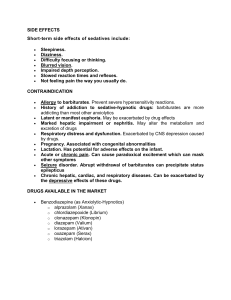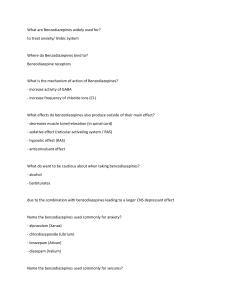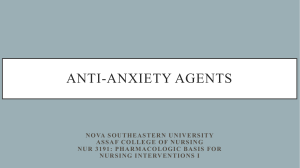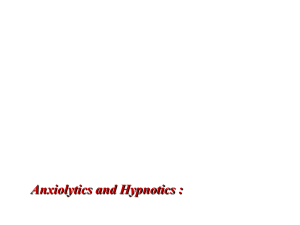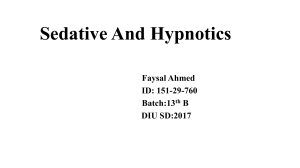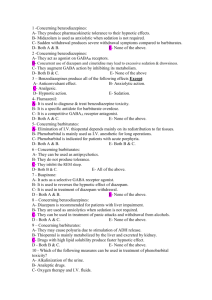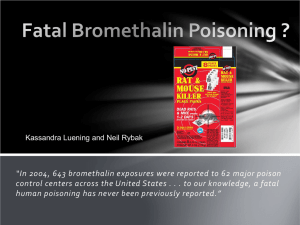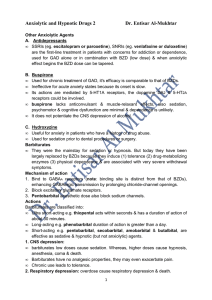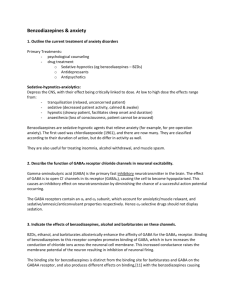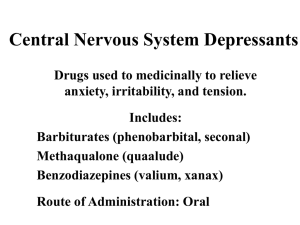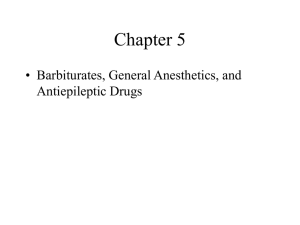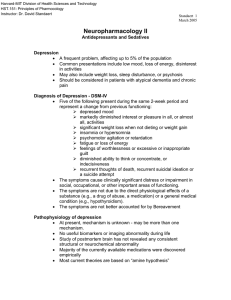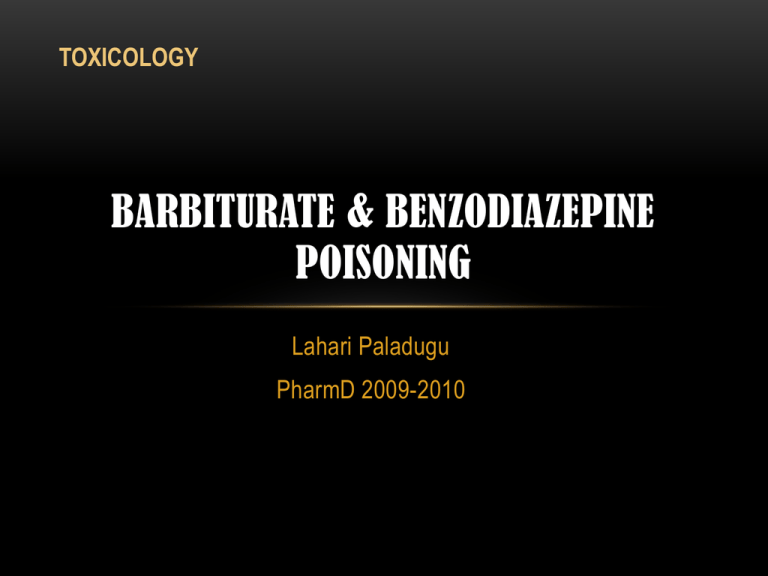
TOXICOLOGY
BARBITURATE & BENZODIAZEPINE
POISONING
Lahari Paladugu
PharmD 2009-2010
WHAT ARE THEY?
• CNS Drugs --- Sedative-Hypnotics
• SEDATIVES: A drug that subdues excitement
and calms the subject without inducing sleep,
though drowsiness may be produced.
• HYPNOTICS: A drug that induces and/or
maintains sleep, similar to normal arousable
sleep.
BARBITURATES
- Long acting: Phenobarbitone
- Short acting: Butobarbitone, Pentobarbitone
- Ultra-short acting: Thiopentane, Methohexitone
BENZODIAZEPINES
- Hypnotic: Diazepam, Flurazepam, Nitrazepam,
Alprazolam, Temazolam, Triazolam
- Antianxiety: Diazepam, Chlordiazepoxide, Oxasepam,
Lorazepam, Alprazolam
- Anticonvulsant: Diazepam, Lorazepam, Clonazepam,
Clobazam
BENZODIAZEPINE
TOXICITY
BENZODIAZEPINES - USES
• Sedative-Hypnotics
• seizure control, anxiety, alcohol withdrawal,
insomnia, control of drug-associated
agitation, as muscle relaxants, and as preanesthetic agents; combined frequently
with other medications for procedural
sedation
Mechanism Of
Action
GABA
BZD Potentiates
GABA
Increased opening
of Cl- Channels
Membrane
Hyperpolarization
HISTORY
• Dizziness
• Confusion
• Drowsiness
• Blurred vision
• Unresponsiveness
• Anxiety
PHYSICAL PRESENTATION
•
•
•
•
•
•
•
•
• Agitation
•
•
•
•
Nystagmus
Hallucinations
Slurred speech
Ataxia
Coma
Hypotonia
Weakness
Altered mental status, impairment of
cognition
Amnesia
Paradoxical agitation
Respiratory depression
Hypotension
ADVERSE EFFECTS
TOXIC EFFECTS
• Weakness, headache,
amnesia, vertigo, diplopia,
nausea, diarrhea, and
rarely chest pain
• Chronic poisoning –
• Development of tolerance
• Abrupt cessation provokes a
mild withdrawal reaction –
anxiety, insomnia, headache,
tremor, paresthesia
• Acute poisoning –
• Mild: drowsiness, ataxia,
weakness
• Moderate to severe – vertigo,
slurred speech, nystagmus,
lethargy, coma. Hypotension
and respiratory depression
supervene in potentially
lethal ingestions.
• Paradoxical effects –
disinhibition of dyscontrol
reaction may sometimes
occur characterized by
restlessness, agitation, and
hallucinations.
DIAGNOSIS
• Gas chromatography- mass spectrometry –
used to analyze urine levels of benzodiazepines
• A less effective alternative is TLC, which can be
done on urine, gastric aspirate, or scene
residue.
• Estimation of plasma levels of benzodiazepines
is usually not necessary.
TREATMENT – ACUTE POISONING
• Decontamination – Stomach wash may be helpful
within 6-12 hours of ingestion. Activated charcoal can
also be given in usual manner.
• Establish a clear airway – Oxygen and assisted
ventilation if necessary.
• IV fluids
• Correction of hypotension with dopamine or
levarterenol.
TREATMENT – ANTIDOTE
• FLUMAZENIL – Antidote which acts by competitive antagonism.
• Complete reversal can be obtained with total slow IV dose of
1 mg
• Can also be admin. In a series of smaller doses in increment
manner, starting with 0.2 mg and progressively increasing by
0.1 – 0.2 mg every minute until a cumulative total dose of 3.5
mg is reached.
• Resedation can occur within 30 minutes to 2 hours…
therefore, patients must be carefully monitored and
subsequent doses of flumazenil must be given as needed.
TREATMENT – CHRONIC POISONING
• Phenobarbitone-substitution technique
• Recommended for benzodiazepine withdrawal
• Propranolol for somatic symptoms
• Phenobarbitone for detoxification
• Replacement of short half-life benzodiazepine with a
longer half-life benzodiazepine, before initiating a taper
and final discontinuation.
BARBITURATE TOXICITY
USES - BARBITURATES
• Treatment of INSOMNIA
• Phenobarbitone for EPILESPY
• Thiopentane for ANAESTHESIA
• Adjuvants in psychosomatic disorders
• Pre-operative sedation
• Treatment of seizure disorder
Enhance
GABA
mediated Cl
currents
Mechanism Of
Action
Increases
duration of
ionophone
opening
Prolongs inhibitory
actions of GABA
BARBITURATES ~ TOXICOKINETICS
• Usually administered orally. Parenteral route is usually
reserved for management of status epilepticus or
induction/maintenance of general anesthesia.
• Following absorption, barbiturates are distributed widely.
• Metabolism – oxidation in liver resulting in the formation of
alcohols, ketones, phenols, or carboxylic acids
• Excretion – in urine as such or in the form of glucuronic
acid conjugates.
BARBITURATES ~ ADVERSE EFFECTS
• Residual depression after the main effect of drug has
passed
• Paradoxical excitement
• Hypersensitivity reaction – localized swelling of
eyelid, cheek, or lip, erythematous or exfoliative
dermatitis
• Synergistic action with ethanol and antihistamines
BARBITURATES ~ TOXIC EFFECTS
• Slurred speech, ataxia, lethargy, confusion, headache,
nystagmus
• CNS depression, coma, shock
• Pupils first constrict and then dilate because of hypoxia
• hypothermia
• Cutaneous bullae
• Death due to respiratory arrest of cardiovascular collapse
• Chronic abuse tolerance.
• Withdrawal reaction: anorexia, tremor, insomnia, cramps,
seizures, delirium, orthostatic hypotension
BARBITURATES ~ USUAL FATAL DOSE
• Phenobarbitone – 6-10 g
• Amobarbitone, pentobarbitone, secobarbitone –
2-3 g
• Lethal blood level for short/intermediate acting
barbiturate varies from 3-4 mg/100mL
• LBL for phenobarbitone varies from 8-15
mg/100mL
BARBITURATES ~ DIAGNOSIS
• TLC – urine, stomach contents,
scene residue
• GC or HPLC
• EEG – alpha coma indicates poor
prognosis
BARBITURATES ~ TREATMENT
• Gastric lavage can be done with benefit upto 6-12 hours
post ingestion
• Activated charcoal can be given at usual dose
• Forced alkaline diuresis is said to be particularly helpful
in the case of phenobarbitone poisoning
• Hemodialysis or haemoperfusion
• Supportive measures – supplemental oxygen,
intubation, assisted ventilation, IV fluids
REFERENCES
• Textbook of Forensic Medicine and
Toxicology by VV Pillay
• Wikipedia
• Medscape
THANK YOU

